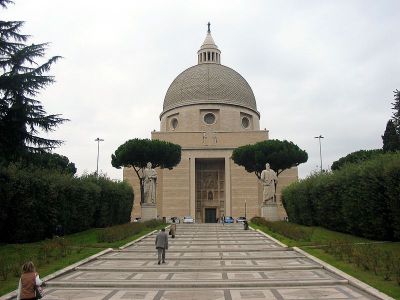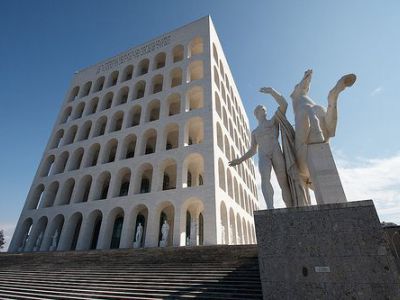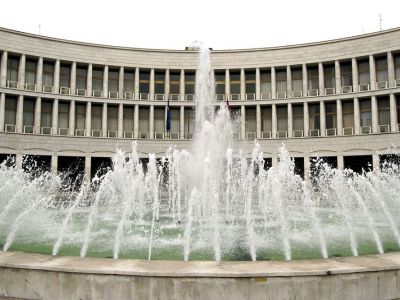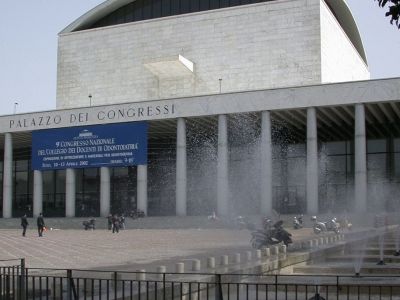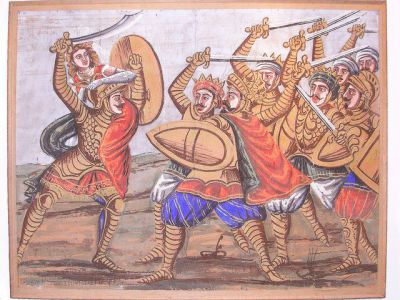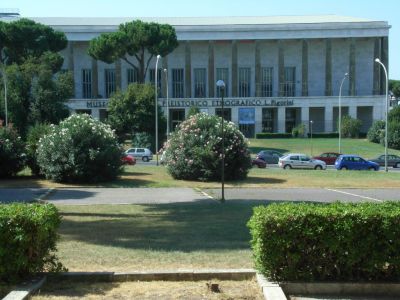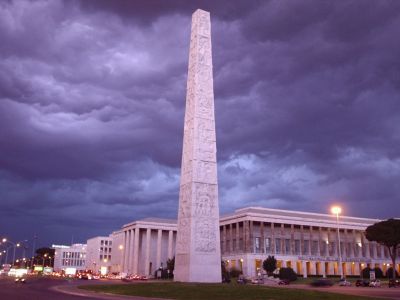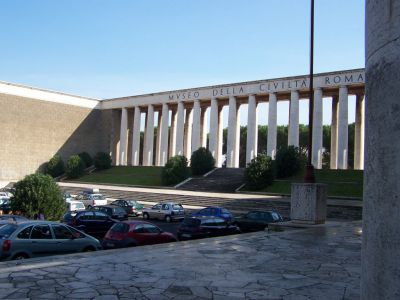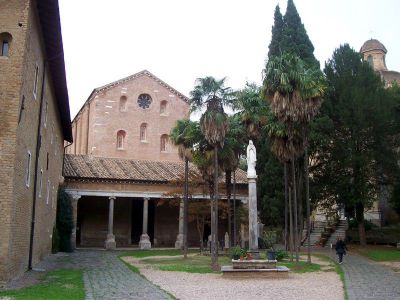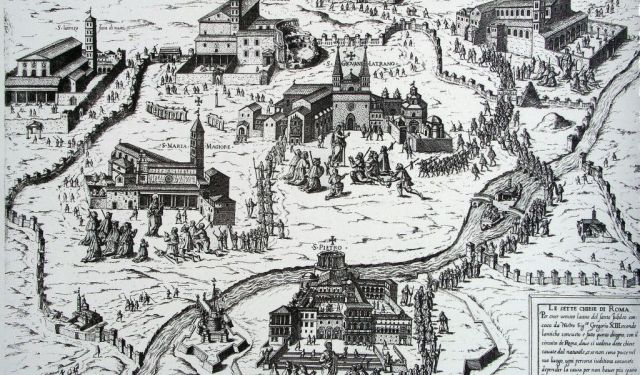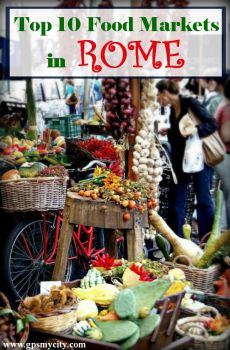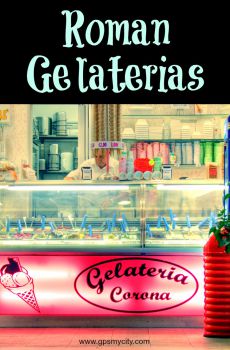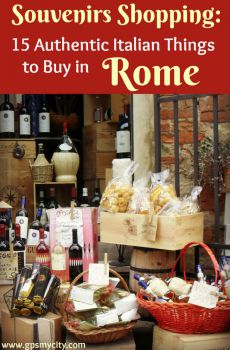EUR Sightseeing Walking Tour (Self Guided), Rome
The Esposizione Universale di Roma (EUR), located in the southern suburb of Rome, was originally constructed for an international exhibition that was planned by Mussolini as a grand celebration of Fascist Italy. However, due to the outbreak of World War II, the exhibition never took place. The architecture of EUR was designed to glorify Fascism and showcases a distinct style that sets it apart from other areas in Rome.
In terms of urban planning, EUR has been remarkably successful, and its modern amenities continue to attract residents who are drawn to the area. Many businesses have established offices in this district. The grand marble halls and imposing buildings, inspired by the architecture of ancient Imperial Rome, now house government offices and a variety of museums.
One of the captivating highlights in EUR is the Museum of Roman Civilization complex. This remarkable museum brings together the collections of several different museums. The Museum of Prehistory and Ethnography, known as "Luigi Pigorini," features exhibits from various cultures and showcases significant prehistoric remains, including a Neanderthal cranium, prehistoric fauna, and well-preserved Neolithic boats. The Museum of Traditional and Folk Art explores the rich cultural heritage of different Italian regions. Additionally, the National Museum of the Early Middle Ages presents a wealth of objects from early medieval Italy and hosts a breathtaking reconstruction of a marble-clad room from Ostia Antica.
Take this self-guided walking tour to make your visit to the EUR area easier to navigate!
In terms of urban planning, EUR has been remarkably successful, and its modern amenities continue to attract residents who are drawn to the area. Many businesses have established offices in this district. The grand marble halls and imposing buildings, inspired by the architecture of ancient Imperial Rome, now house government offices and a variety of museums.
One of the captivating highlights in EUR is the Museum of Roman Civilization complex. This remarkable museum brings together the collections of several different museums. The Museum of Prehistory and Ethnography, known as "Luigi Pigorini," features exhibits from various cultures and showcases significant prehistoric remains, including a Neanderthal cranium, prehistoric fauna, and well-preserved Neolithic boats. The Museum of Traditional and Folk Art explores the rich cultural heritage of different Italian regions. Additionally, the National Museum of the Early Middle Ages presents a wealth of objects from early medieval Italy and hosts a breathtaking reconstruction of a marble-clad room from Ostia Antica.
Take this self-guided walking tour to make your visit to the EUR area easier to navigate!
How it works: Download the app "GPSmyCity: Walks in 1K+ Cities" from Apple App Store or Google Play Store to your mobile phone or tablet. The app turns your mobile device into a personal tour guide and its built-in GPS navigation functions guide you from one tour stop to next. The app works offline, so no data plan is needed when traveling abroad.
EUR Sightseeing Walking Tour Map
Guide Name: EUR Sightseeing Walking Tour
Guide Location: Italy » Rome (See other walking tours in Rome)
Guide Type: Self-guided Walking Tour (Sightseeing)
# of Attractions: 9
Tour Duration: 2 Hour(s)
Travel Distance: 3.6 Km or 2.2 Miles
Author: audrey
Sight(s) Featured in This Guide:
Guide Location: Italy » Rome (See other walking tours in Rome)
Guide Type: Self-guided Walking Tour (Sightseeing)
# of Attractions: 9
Tour Duration: 2 Hour(s)
Travel Distance: 3.6 Km or 2.2 Miles
Author: audrey
Sight(s) Featured in This Guide:
- Basilica dei Santi Pietro e Paolo (Basilica of Saints Peter and Paul)
- Palazzo della Civilta Italiana (Palace of Italian Civilization)
- Palazzi dell'INA e dell'INPS (INA-INPS Buildings)
- Palazzo dei Congressi (Palace of Congresses)
- Museo Nazionale delle Arti e Tradizioni Popolari (National Museum of Traditional and Folk Art)
- Museo nazionale preistorico etnografico Luigi Pigori (National Museum of Prehistory and Ethnography)
- Obelisco di Marconi (Marconi Obelisk)
- Museo della Civilta Romana (Museum of the Roman Civilization)
- Chiesa di San Paolo alle Tre Fontane (Church of St. Paul at the Three Fountains)
1) Basilica dei Santi Pietro e Paolo (Basilica of Saints Peter and Paul)
The monumental temple of Saints Peter and Paul in Rome stands proudly at the highest point of the EUR district. Designed by architect Arnaldo Foschini, the temple features a central Greek cross plan and boasts one of Rome's most impressive hemispherical domes, measuring 32 meters in diameter. Completing the architectural composition are the side porticoes, housing two magnificent statues depicting the patron saints Peter and Paul, as well as a grand staircase that connects the church square to Viale Europa below.
Atop the spire of the lantern, an angel sculpted in bronze by Carmelo Abate catches the eye. Two large angels by Federico Papi flank the cross in the center of the façade. A significant feature of the façade is a sizable high relief depicting Christ handing the keys to Saint Peter, a masterpiece by sculptor Giovanni Prini. Prini also crafted the splendid bronze door divided into ten panels, showcasing the works of Saints Peter and Paul. The niches of the façade house two notable reliefs: Alessandro Monteleone's "The Crucifixion of Saint Peter" in travertine on the right, and Carlo Pini's "The Beheading of Saint Paul" on the left. Venanzio Crocetti's "The Conversion of Saint Paul" adorns the front. Inside the niches and internal chapels, Francesco Coccia's decorative motifs of geometric and symbolic nature add to the ambiance.
Dominating the backdrop of the apse, above the main altar, is a majestic sculpture of the triumphant Christ by Attilio Selva. This striking work is set within a mosaic depicting the Martyrdom and Glorification of the apostles Peter and Paul, created by Selva's son, Sergio. The bronze Crucifix adorning the altar is the masterful creation of Giuseppe Graziosi from Modena. Bronze ambos, cast with reliefs portraying key moments in the preaching of Saint Peter and Saint Paul, were crafted by Duilio Cambellotti. The left chapel, dedicated to the Immaculate Conception, showcases a mosaic by Bruno Saetti portraying the Madonna and Child encircled by a crown of angels. On the right side, the baptismal font, embellished with mosaics and marble, captures attention, while Andrea Spadini's bronze group depicting the Baptism of Jesus rests on the font. To the right of the entrance, the chapel of Saint Anthony contains the works in terracotta by painter Franco Petruzzi, added during its restoration in 1978.
Atop the spire of the lantern, an angel sculpted in bronze by Carmelo Abate catches the eye. Two large angels by Federico Papi flank the cross in the center of the façade. A significant feature of the façade is a sizable high relief depicting Christ handing the keys to Saint Peter, a masterpiece by sculptor Giovanni Prini. Prini also crafted the splendid bronze door divided into ten panels, showcasing the works of Saints Peter and Paul. The niches of the façade house two notable reliefs: Alessandro Monteleone's "The Crucifixion of Saint Peter" in travertine on the right, and Carlo Pini's "The Beheading of Saint Paul" on the left. Venanzio Crocetti's "The Conversion of Saint Paul" adorns the front. Inside the niches and internal chapels, Francesco Coccia's decorative motifs of geometric and symbolic nature add to the ambiance.
Dominating the backdrop of the apse, above the main altar, is a majestic sculpture of the triumphant Christ by Attilio Selva. This striking work is set within a mosaic depicting the Martyrdom and Glorification of the apostles Peter and Paul, created by Selva's son, Sergio. The bronze Crucifix adorning the altar is the masterful creation of Giuseppe Graziosi from Modena. Bronze ambos, cast with reliefs portraying key moments in the preaching of Saint Peter and Saint Paul, were crafted by Duilio Cambellotti. The left chapel, dedicated to the Immaculate Conception, showcases a mosaic by Bruno Saetti portraying the Madonna and Child encircled by a crown of angels. On the right side, the baptismal font, embellished with mosaics and marble, captures attention, while Andrea Spadini's bronze group depicting the Baptism of Jesus rests on the font. To the right of the entrance, the chapel of Saint Anthony contains the works in terracotta by painter Franco Petruzzi, added during its restoration in 1978.
2) Palazzo della Civilta Italiana (Palace of Italian Civilization)
Undoubtedly, the most impressive and emblematic structure in Rome's EUR district is the Palazzo della Civiltà Italiana (commonly referred to as the "Square Colosseum"), commissioned by Benito Mussolini with the intention of making it the centerpiece of the 1942 World's Fair. Construction began in 1938 and was completed in 1943. Unfortunately, due to the outbreak of the Second World War, the fair never took place. Nevertheless, the building stands today as a symbol of Italian Fascist architecture.
Mussolini envisioned a monument that would evoke the grandeur of the ancient Colosseum and convey the notion of everlasting fascism. Rising 68 meters high and covering over 8000 square meters, the palace consists of six levels, each adorned with nine arches-a deliberate choice by Mussolini to match the number of letters in his name. The structure is constructed using limestone and tuff, a type of rock formed from consolidated volcanic ash, and is clad in marble.
Adorning the upper section of the building, on either side, are inscriptions that proclaim: "A nation of poets, of artists, of heroes, of saints, of thinkers, of scientists, of sailors, of transmigrates". The palace is adorned with numerous statues, including equestrian statues of Castor and Pollux, as well as twenty-eight figures representing Italian excellence across various domains, such as agriculture, the arts, astronomy, craftsmanship, philosophy, and political genius.
Mussolini envisioned a monument that would evoke the grandeur of the ancient Colosseum and convey the notion of everlasting fascism. Rising 68 meters high and covering over 8000 square meters, the palace consists of six levels, each adorned with nine arches-a deliberate choice by Mussolini to match the number of letters in his name. The structure is constructed using limestone and tuff, a type of rock formed from consolidated volcanic ash, and is clad in marble.
Adorning the upper section of the building, on either side, are inscriptions that proclaim: "A nation of poets, of artists, of heroes, of saints, of thinkers, of scientists, of sailors, of transmigrates". The palace is adorned with numerous statues, including equestrian statues of Castor and Pollux, as well as twenty-eight figures representing Italian excellence across various domains, such as agriculture, the arts, astronomy, craftsmanship, philosophy, and political genius.
3) Palazzi dell'INA e dell'INPS (INA-INPS Buildings)
Situated on the United Nations Square ("Piazzale delle Nazioni Unite"), two buildings stand side by side, bearing a resemblance yet showcasing slight differences. To the left is the Palazzo dell'INPS, while on the right stands the Palazzo dell'INA. Both structures feature a semi-circular design, influenced by the classical Roman Markets of Trajan, as envisioned by the architects Muzio-Paniconi-Pediconi. Their distinctive shape was originally intended to be part of an Imperial Gate, intended to welcome visitors to the 1942 World's Fair. These "different twins" are constructed from reinforced concrete and adorned with marble sourced from the Apuan Alps.
Notably, each building is adorned with a pair of bas-reliefs, crafted by different artists but united in their portrayal of a female figure larger than the rest. This symbolizes the strength and unity of the fascist regime that spearheaded the construction of the EUR district.
The INPS building showcases "The Maritime Republics" by Mirko Basaldella and "Rome against Carthage" by Giuseppe Mazzullo. Furthermore, this building, which has always served as the national headquarters of the National Social Security Institute, features additional bas-reliefs at its entrance, created by Antonio Cocchioni. As for the INA building, it features "The Conquests of the Seas" by Oddo Aliventi and "The Fascist Empire" by Quirino Ruggeri. Worth noting also are the grand vaulted colonnades present in both buildings.
Notably, each building is adorned with a pair of bas-reliefs, crafted by different artists but united in their portrayal of a female figure larger than the rest. This symbolizes the strength and unity of the fascist regime that spearheaded the construction of the EUR district.
The INPS building showcases "The Maritime Republics" by Mirko Basaldella and "Rome against Carthage" by Giuseppe Mazzullo. Furthermore, this building, which has always served as the national headquarters of the National Social Security Institute, features additional bas-reliefs at its entrance, created by Antonio Cocchioni. As for the INA building, it features "The Conquests of the Seas" by Oddo Aliventi and "The Fascist Empire" by Quirino Ruggeri. Worth noting also are the grand vaulted colonnades present in both buildings.
4) Palazzo dei Congressi (Palace of Congresses)
Located in the heart of the EUR district, the Palace of Congresses is worth visiting due to the constant presence of intriguing events and activities.. Designed by Adalberto Libera, this building stands as one of his rare creations following the Italian Rationalism School of Architecture. Blending classical and modern elements, it was originally intended to be a part of the 1942 World's Fair. Construction began in 1938 but was interrupted during World War II, and the palace was finally completed in 1954.
The palace is vast, serving as the largest conference complex in Italy. Its centerpiece is the enormous Reception Hall, spanning an impressive 1444 square meters, which could easily accommodate the Pantheon within its walls. This versatile space is utilized for exhibitions, trade fairs, and concerts. Additionally, the palace houses conference rooms and an amphitheater with a seating capacity of up to 1150 people. For grand banquets, the magnificent Banquet Room provides seating for 850 diners at round tables.
All the rooms within the palace are elegantly adorned with marble colonnades and adorned with paintings by renowned 20th-century Italian artists. Notably, the Kennedy Hall features a captivating fresco executed by Achille Funi in 1953, depicting scenes depicting the origins of Rome. Moreover, the palazzo's café is embellished with two mosaics created by Angelo Canevari. Recently refurbished, the main conference room boasts a lovely terrace adorned with vibrant flowers in hanging baskets. During the summer, this terrace transforms into an open-air theater, adding to the palazzo's allure.
The palace is vast, serving as the largest conference complex in Italy. Its centerpiece is the enormous Reception Hall, spanning an impressive 1444 square meters, which could easily accommodate the Pantheon within its walls. This versatile space is utilized for exhibitions, trade fairs, and concerts. Additionally, the palace houses conference rooms and an amphitheater with a seating capacity of up to 1150 people. For grand banquets, the magnificent Banquet Room provides seating for 850 diners at round tables.
All the rooms within the palace are elegantly adorned with marble colonnades and adorned with paintings by renowned 20th-century Italian artists. Notably, the Kennedy Hall features a captivating fresco executed by Achille Funi in 1953, depicting scenes depicting the origins of Rome. Moreover, the palazzo's café is embellished with two mosaics created by Angelo Canevari. Recently refurbished, the main conference room boasts a lovely terrace adorned with vibrant flowers in hanging baskets. During the summer, this terrace transforms into an open-air theater, adding to the palazzo's allure.
5) Museo Nazionale delle Arti e Tradizioni Popolari (National Museum of Traditional and Folk Art)
Located in the EUR district, this large and captivating museum is the only one of its kind in Italy. Its early collection was initially exhibited in the 1911 Ethnographic Exhibition, held to commemorate the 50th anniversary of the Unification of Italy. Following the exhibition, the collection found its home in the current building, which became part of the EUR district in the late 1950s.
Dedicated to exploring the lesser-known aspects of Italian life, the museum offers insights into the individuals who ensured the delivery of food and wine to the tables of the affluent across the city. Its various sections showcase a range of artifacts from all over Italy, including farming tools, traditional costumes, ceramics, and more.
Noteworthy exhibits include religious items, such as crude paintings depicting people afflicted with various ailments and wax body parts. These were created as offerings to express gratitude to the saints for their deliverance from specific ailments. Given the peasants' limited financial means, they offered whatever they could. The ground floor of the museum features brightly painted carts that were used to transport goods from the countryside to marketplaces, as well as a gondola presented to Queen Margaret of Savoy in 1882.
Other highlights include the puppet theater and the 12 masks of the Procession of San Sosti, painted masks worn by dancers during spring and autumn festivals. The museum's collection of approximately 750 regional costumes not only includes those from Italy and its islands but also from Greece, Albania, Austria, Germany, France, Spain, and North Africa.
Dedicated to exploring the lesser-known aspects of Italian life, the museum offers insights into the individuals who ensured the delivery of food and wine to the tables of the affluent across the city. Its various sections showcase a range of artifacts from all over Italy, including farming tools, traditional costumes, ceramics, and more.
Noteworthy exhibits include religious items, such as crude paintings depicting people afflicted with various ailments and wax body parts. These were created as offerings to express gratitude to the saints for their deliverance from specific ailments. Given the peasants' limited financial means, they offered whatever they could. The ground floor of the museum features brightly painted carts that were used to transport goods from the countryside to marketplaces, as well as a gondola presented to Queen Margaret of Savoy in 1882.
Other highlights include the puppet theater and the 12 masks of the Procession of San Sosti, painted masks worn by dancers during spring and autumn festivals. The museum's collection of approximately 750 regional costumes not only includes those from Italy and its islands but also from Greece, Albania, Austria, Germany, France, Spain, and North Africa.
6) Museo nazionale preistorico etnografico Luigi Pigori (National Museum of Prehistory and Ethnography)
When exploring Rome's EUR district, be sure to visit this museum, established in 1875 by the renowned paleontologist Luigi Pigorini. As you enter, you'll find a bust of him in the entrance hall. The museum's origins trace back to 1650 when Jesuit scholar Athanasius Kircher founded the initial collection of prehistoric artifacts. Over time, Kircher's collection expanded through donations from colleagues who had visited Brazil, Canada, and China, as well as from missionaries in Angola and the Congo.
Today, Kircher's collection is on display in the museum, which serves both educational and research purposes, providing insights into the progression and development of humanity. In the Ethnography section, you will encounter over 60,000 artifacts representing Mediterranean culture, along with objects from Africa, Oceania, and the Americas. The museum also boasts a remarkable collection of Neolithic items originating from Lake Bracciano, where the remains of an Early Neolithic lakeshore village were unearthed.
In the Anthropology section, you will discover skeletal remains arranged chronologically, spanning from the 6th century BC to the late Middle Ages. Additionally, there are captivating mosaics and stucco decorations originating from an ancient Roman necropolis discovered on Isola Sacra during archaeological excavations.
Today, Kircher's collection is on display in the museum, which serves both educational and research purposes, providing insights into the progression and development of humanity. In the Ethnography section, you will encounter over 60,000 artifacts representing Mediterranean culture, along with objects from Africa, Oceania, and the Americas. The museum also boasts a remarkable collection of Neolithic items originating from Lake Bracciano, where the remains of an Early Neolithic lakeshore village were unearthed.
In the Anthropology section, you will discover skeletal remains arranged chronologically, spanning from the 6th century BC to the late Middle Ages. Additionally, there are captivating mosaics and stucco decorations originating from an ancient Roman necropolis discovered on Isola Sacra during archaeological excavations.
7) Obelisco di Marconi (Marconi Obelisk)
The Marconi Obelisk, also known as the Obelisk of EUR, is considered one of the most contemporary obelisks in Rome, alongside the Obelisco Novecento and the obelisks of the Foro Italico, Villa Torlonia, and Villa Medici. Originally intended to adorn Piazza Imperiale, which was planned to be the central square of the newly developed district according to the project for the 1942 World's Fair in Rome, the obelisk was also meant to commemorate physicist, inventor, and senator Guglielmo Marconi, famous for his development of the radio telegraph system, who had passed away two years prior. The monument was finally completed and inaugurated in December 1959.
The Marconi Obelisk stands at the center of the square, which is now named after Guglielmo Marconi. The structure itself takes the form of a truncated pyramid, constructed using reinforced concrete covered by 92 Carrara marble slabs. These marble slabs feature high relief carvings arranged in four rows, adding artistic intricacy to the monument.
The Marconi Obelisk stands at the center of the square, which is now named after Guglielmo Marconi. The structure itself takes the form of a truncated pyramid, constructed using reinforced concrete covered by 92 Carrara marble slabs. These marble slabs feature high relief carvings arranged in four rows, adding artistic intricacy to the monument.
8) Museo della Civilta Romana (Museum of the Roman Civilization)
The EUR district in Rome is a culturally rich area, home to several museums. Among them, the Museum of Roman Civilization is dedicated to Ancient Rome, spanning from the city's foundation to the 4th century. The space is divided into three sections, each filled with fascinating cultural artifacts and intricate models.
The Historical Section offers a journey through Roman legends, delving into the origins of the ancient city. Visitors can explore items from primitive culture, learn about the conquest of the Mediterranean region, and trace the expansion of the Roman Empire. Engaging insights are provided about the renowned Roman Legions, the emperors, and the arrival of Christianity, which marked the beginning of Rome's association with the Catholic faith.
The Thematic Section focuses on the daily life of early Romans, exploring aspects such as agriculture, literature, medicine, music, and schools. Notably, a remarkable series of plaster casts depicting the frieze in bas-relief from the Trajan Column can be found at eye-level for easy viewing.
The highlight of the museum lies in its third section. Here, visitors will encounter an astonishing plaster model of 4th century Rome. This meticulously crafted scale model boasts incredible detail and was the labor of love of its creator, Italo Gismondi, who dedicated over 35 years to its completion.
Editor's note: The museum is temporarily closed in order to carry out necessary renovation works.
The Historical Section offers a journey through Roman legends, delving into the origins of the ancient city. Visitors can explore items from primitive culture, learn about the conquest of the Mediterranean region, and trace the expansion of the Roman Empire. Engaging insights are provided about the renowned Roman Legions, the emperors, and the arrival of Christianity, which marked the beginning of Rome's association with the Catholic faith.
The Thematic Section focuses on the daily life of early Romans, exploring aspects such as agriculture, literature, medicine, music, and schools. Notably, a remarkable series of plaster casts depicting the frieze in bas-relief from the Trajan Column can be found at eye-level for easy viewing.
The highlight of the museum lies in its third section. Here, visitors will encounter an astonishing plaster model of 4th century Rome. This meticulously crafted scale model boasts incredible detail and was the labor of love of its creator, Italo Gismondi, who dedicated over 35 years to its completion.
Editor's note: The museum is temporarily closed in order to carry out necessary renovation works.
9) Chiesa di San Paolo alle Tre Fontane (Church of St. Paul at the Three Fountains)
According to legend, this church was constructed on the site where Saint Paul was beheaded around 67 AD. As a Roman citizen, he was granted the somewhat peculiar privilege of being beheaded instead of being crucified, which was considered more humane and reserved for foreigners and criminals. The legend states that his head bounced three times upon being severed, and a fountain sprang up at each spot where it landed – with hot, tepid, and cold water in succession. This gave rise to the name of the church, although the fountains are actually about 20 feet apart, making the bouncing theory somewhat impractical. Nonetheless, the first church was built on this location in the 6th century and later reconstructed in 1599 by Giacomo della Porta.
Inside the church, to the left of the altar, you will find the thick column to which Saint Paul was tied during his martyrdom. One of the chapels houses a copy of Guido Reni's "Crucifixion," while the original painting can be seen in the Pinacoteca Vaticana within the Vatican Museums. Bartolomeo Passarotti's painting "The Beheading" is displayed near the altar of Saint Paul.
The floor of the church features a well-preserved ancient Roman mosaic from the 2nd century. Originally located in the Mithraeum of the Imperial Palace in Ostia Antica, this mosaic portrays the "Four Seasons." Additionally, high-reliefs of Saints Peter and Paul adorn the side walls of the vestibule, which was previously the oratory. The floor mosaic in the vestibule predates the construction of the church.
Inside the church, to the left of the altar, you will find the thick column to which Saint Paul was tied during his martyrdom. One of the chapels houses a copy of Guido Reni's "Crucifixion," while the original painting can be seen in the Pinacoteca Vaticana within the Vatican Museums. Bartolomeo Passarotti's painting "The Beheading" is displayed near the altar of Saint Paul.
The floor of the church features a well-preserved ancient Roman mosaic from the 2nd century. Originally located in the Mithraeum of the Imperial Palace in Ostia Antica, this mosaic portrays the "Four Seasons." Additionally, high-reliefs of Saints Peter and Paul adorn the side walls of the vestibule, which was previously the oratory. The floor mosaic in the vestibule predates the construction of the church.
Walking Tours in Rome, Italy
Create Your Own Walk in Rome
Creating your own self-guided walk in Rome is easy and fun. Choose the city attractions that you want to see and a walk route map will be created just for you. You can even set your hotel as the start point of the walk.
Vatican Walking Tour
Consisting of a walled enclave within the city of Rome, the Vatican is the world’s smallest sovereign state, as well as a symbol (and headquarters) of the Roman Catholic faith. Although only 44 hectares in surface, one is amazed by the vastness of this place and the sheer size of everything. When gazing around in all directions, you realize how much can be achieved by people working in faith for... view more
Tour Duration: 2 Hour(s)
Travel Distance: 3.4 Km or 2.1 Miles
Tour Duration: 2 Hour(s)
Travel Distance: 3.4 Km or 2.1 Miles
Palatine Hill Walking Tour
Palatine Hill — one of Rome’s legendary Seven Hills — is the most ancient part of the city. According to mythology (and a fair bit of archaeology backing it up), this is where the whole Roman saga began to unfold in the year 753 BC when young Romulus pointed dramatically at the hill and probably thought to himself: “Yes, this is the spot.” And just like that, a city that would eventually... view more
Tour Duration: 2 Hour(s)
Travel Distance: 2.6 Km or 1.6 Miles
Tour Duration: 2 Hour(s)
Travel Distance: 2.6 Km or 1.6 Miles
Rome Introduction Walking Tour II
Rome, the Eternal City, carries a legacy shaped by centuries of resilience, transformation, and cultural flourishing. The fall of the Roman Empire in 476 AD marked the end of an era, plunging Western Europe into the dark Middle Ages. Yet, even amid the disarray, Rome endured as a beacon of unity, largely due to its status as the center of Catholicism. The papacy wielded spiritual influence,... view more
Tour Duration: 2 Hour(s)
Travel Distance: 3.4 Km or 2.1 Miles
Tour Duration: 2 Hour(s)
Travel Distance: 3.4 Km or 2.1 Miles
Hidden Art Treasures in Rome
Rome is one of the world's top living museums, replete with some of the most iconic pieces of art on the face of the planet. Famous artists, such as Michelangelo, Caravaggio, Raphael, Bernini, to mention but a few, had lived and worked here and left indelible marks in the city.
Needless to say that the abundance of masterpieces makes Rome crowded with tourists anxious to see them, causing... view more
Tour Duration: 1 Hour(s)
Travel Distance: 2.6 Km or 1.6 Miles
Needless to say that the abundance of masterpieces makes Rome crowded with tourists anxious to see them, causing... view more
Tour Duration: 1 Hour(s)
Travel Distance: 2.6 Km or 1.6 Miles
Seven Pilgrim Churches of Rome Walking Tour
Rome has long played host to pilgrims-after all, it's home to the Pope, the Catholic Curia, and a treasure trove of relics linked to apostles, saints, and martyrs. Back in the day, the Via Francigena provided a straight shot for the faithful traveling from England to Rome. Upon arrival, it was tradition to visit the tombs of Saints Peter and Paul. When a Jubilee rolled around, the spiritual... view more
Tour Duration: 6 Hour(s)
Travel Distance: 17.4 Km or 10.8 Miles
Tour Duration: 6 Hour(s)
Travel Distance: 17.4 Km or 10.8 Miles
Trastevere Walking Tour
Heading down from the Vatican along the River Tiber, one is bound to find yet another city hidden within the city – Trastevere. This name translates literally to "across the Tiber". Indeed, crossing the picturesque Ponte Sisto (Sisto Bridge) to the west bank, you will find yourself in a charming neighborhood with a distinct character that sets it apart from any other part of Rome.
... view more
Tour Duration: 2 Hour(s)
Travel Distance: 3.0 Km or 1.9 Miles
... view more
Tour Duration: 2 Hour(s)
Travel Distance: 3.0 Km or 1.9 Miles
Useful Travel Guides for Planning Your Trip
10 Best Food Markets in Rome Italy
Of all the things Italy is most famous for (cars, music, fashion, movies, etc.), food is, undoubtedly, top of the list. Rome may well not be the whole Italy, but no Italy is whole without Rome... And the Romans, much as all their fellow-Italians, like it "fresco", hence the abundance of...
17 Best Gelaterias in Rome Italy
For ice cream lovers and dabblers this guide is a treasure chest of Rome’s best gelato shops. There are gelaterias everywhere. Many visitors to Rome only have a few days to explore the city. You owe it to yourself to make the most of your time and find the gelato locals eat. Often the authentic...
Souvenirs Shopping: 15 Authentic Italian Things To Buy in Rome
Rome is the Eternal City and, as such, the list of gift options available here is countless. Whether it's something edible, drinkable, wearable or pleasing to the eye that you want - you will find it all here in abundance. However, if time or budget is the factor, perhaps you might want to...
The Most Popular Cities
/ view all



